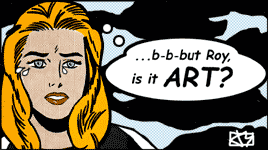the review site with a difference since 1999
Image Entertainment presentsRoy Lichtenstein
(1991)
"As it is the actual drawing that is in the projector, he is, in fact, enlarging exactly the same image onto the canvas."- Melvyn Bragg, presenter
Stars: Roy Lichtenstein
Other Stars: Melvyn Bragg, Leo Castelli, Diane Waldman, Ingrid Sischy, William Overgard
Director: Chris Hunt
Manufacturer: WAMO
MPAA Rating: Not Rated for (safe for all ages)
Run Time: 00h:53m:00s
Release Date: 2000-12-12
Genre: art
| Style Grade |
Substance Grade | Image Transfer Grade | Audio Transfer Grade |
Extras Grade |
|---|---|---|---|---|
| B | C+ | B- | B | D- |
DVD Review
Artist Eleanor Dickinsen once told me that she had the opportunity to ask H. W. Janson, author of the definitive History of Art, why he had not included any women artists in his venerated tome. His reply had been, "No woman has ever changed the face of art history." If I had this same opportunity, my follow up would have been, "Then why include Roy Lichtenstein?"
Born in New York, there is no doubt Roy Lichtenstein is an American phenomenon. This means something completely different to the public at large; to me, I mean his successful career could only have happened in our pop-culture-oriented society.
To date, I have reviewed programs focused on the life and work of Man Ray, David Hockney and Andy Warhol. I am a fan of the first two, and I mildly tolerate Warhol, perhaps more so after having viewed the DVD presentation of his life. Lichtenstein is another story. I tried, as with Warhol, to keep an open mind, to find something I could cling to, a perspective to better appreciate his work; unfortunately, I was driven deeper towards my personal distaste for him.
It is always fascinating to watch an artist at work, and the viewer is treated to much of this here, as the artist was alive at the time this feature was developed. He explains, in detail, his process, a rare opportunity to gain great insight into what an artist is thinking, and how creative choices are made—a glorious thing, if only this was Rembrandt. Sadly, it is not; nor is this Matisse composing with color, or Picasso expanding the perceived boundaries of the picture plane: this is Roy Lichtenstein telling us, "Things like explosions and people dying in airplanes all becomes a kind of beautiful design instead. And that's another kind of interesting part—almost not thinking about the consequences, but simply a way of painting." (I try to understand, but then imagine what Picasso would tell us about his Guernica).
The most entertaining segment comes in chapter 4, in which William Overgard, creator of the Steve Roper comicstrip, discusses his reaction at the time he discovered one of his panels, converted by Lichtenstein, hanging at the Guggenheim. They are each interviewed—separately—and while Lichtenstein attempts to paint the controversy over with happy, primary colors, one understands that Overgard still harbors resentment, especially apparent when he refers to the more successful man as Lichtenberg.
Beyond his most famous comic book series, Lichtenstein has adapted works by Picasso, Leger, Monet and Mondrian, among others, to—as he says—cartoons. Claiming never to have seen the original paintings he "re-paints," he bases his creations on printed reproductions from various sources. But his later work returns to his comic book origins, with a unique twist: he paints large diagonal stripes across the image, imitating light reflections that would obscure what is behind them if the image were behind glass.
Okay. I am not a fan. But I have a large library of art books and I am deliriously enthused that I can now have a living history of art on DVD. Roy Lichtenstein's amazing success is a good lesson that every artist should understand. But to quote the words Roy put in Steve Roper's mouth, in his version of the Overgard image mentioned above:
"I can see the whole gallery - and there's no art in it!"
Rating for Style: B
Rating for Substance: C+
Image Transfer
| One | |
|---|---|
| Aspect Ratio | 1.33:1 - Full Frame |
| Original Aspect Ratio | yes |
| Anamorphic | no |
Image Transfer Review: Image has done a decent job on the transfer of this documentary, originally produced for British television (the South Bank Show), and it is in pretty good shape overall. There are a few flecks and "butterflies", but the color is consistent, albeit on that Kodak-y blue side.
Featured on this disc is Lichtenstein's series based on Monet's studies, La cathedrale de Rouen (Rouen Cathedral), and I happened to have the opportunity, just last week, to see his "mechanical" versions at the San Francisco MOMA. I can personally assure you, dear readers, this DVD does them all the justice they deserve.
Image Transfer Grade: B-
Audio Transfer
| Language | Remote Access | |
|---|---|---|
| Mono | English | no |
Audio Transfer Review: The audio is a suitable Dolby Digital mono track, clear and even, with the voiceovers blending well with the interview sections. Nothing remarkable.
Audio Transfer Grade: B
Disc Extras
Static menuScene Access with 10 cues and remote access
Packaging: Snapper
1 Disc
1-Sided disc(s)
Layers: single
Extras Review: There are no extras of any sort. A static menu with an adequate 10 chapter-stops, which are also listed inside the Snapper case. The cover art is as it should be, although I would recommend a better color choice to the designer.
Extras Grade: D-
Final Comments
I cannot say this enough: having the lives and work of artists available on DVD is an important use of this versatile medium. Roy Lichtenstein is a well-produced program that at once documents the artist's work and re-animates the controversies surrounding it. If you are a fan, rest assured that some of the interviewees hold him in high regard and are much kinder to him than I am.debi lee mandel 2001-02-26
